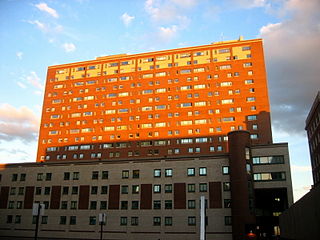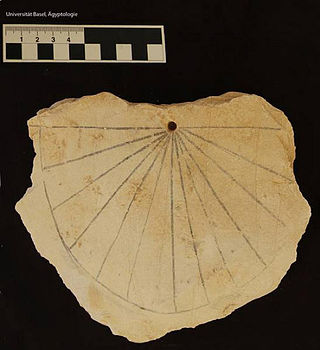
A sundial is a horological device that tells the time of day when direct sunlight shines by the apparent position of the Sun in the sky. In the narrowest sense of the word, it consists of a flat plate and a gnomon, which casts a shadow onto the dial. As the Sun appears to move through the sky, the shadow aligns with different hour-lines, which are marked on the dial to indicate the time of day. The style is the time-telling edge of the gnomon, though a single point or nodus may be used. The gnomon casts a broad shadow; the shadow of the style shows the time. The gnomon may be a rod, wire, or elaborately decorated metal casting. The style must be parallel to the axis of the Earth's rotation for the sundial to be accurate throughout the year. The style's angle from horizontal is equal to the sundial's geographical latitude.
Columbia University in New York City has an extensive tunnel system underneath its Morningside Heights campus connecting many of its buildings, used by the university as conduits for steam, electricity, telecommunications, and other infrastructure. Throughout their history, the tunnels have also been used for other purposes, mostly centering around transportation. During the first half of the 20th century, they were used by students to avoid aboveground traffic. When the university housed the Manhattan Project, they were allegedly used to move radioactive material between buildings. During the Columbia University protests of 1968, students used the tunnels to facilitate their occupation of buildings on campus.

Lee Carroll Bollinger is an American attorney and educator who served as the 19th president of Columbia University from 2002 to 2023 and as president of the University of Michigan from 1996 to 2002. He is currently the Seth Low Professor of the University and a faculty member of Columbia Law School. He is a noted legal scholar of the First Amendment and freedom of speech. While serving as President of the University of Michigan, he was at the center of two notable United States Supreme Court cases regarding the use of affirmative action in admissions processes. He also served as chair of the Federal Reserve Bank of New York board of directors for 2011, and was a member of the board from 2006 to 2012.

WKCR-FM is a radio station licensed to New York, New York, United States. The station is owned by Columbia University and serves the New York metropolitan area. Founded in 1941, the station traces its history back to 1908 with the first operations of the Columbia University Radio Club (CURC). In 1956, it became one of the first college radio stations to adopt FM broadcasting, which had been invented two decades earlier by Professor Edwin Howard Armstrong. The station was preceded by student involvement in W2XMN, an experimental FM station founded by Armstrong, for which the CURC provided programming. Originally an education-focused station, since the Columbia University protests of 1968, WKCR-FM has shifted its focus towards alternative musical programming, with an emphasis on jazz, classical, and hip hop.
In 1968, a series of protests at Columbia University in New York City were one among the various student demonstrations that occurred around the globe in that year. The Columbia protests erupted over the spring of that year after students discovered links between the university and the institutional apparatus supporting the United States' involvement in the Vietnam War, as well as their concern over an allegedly segregated gymnasium to be constructed in the nearby Morningside Park. The protests resulted in the student occupation of many university buildings and the eventual violent removal of protesters by the New York City Police Department.
The Columbia Daily Spectator is the student newspaper of Columbia University. Founded in 1877, it is the oldest continuously operating college news daily in the nation after The Harvard Crimson, and has been legally independent from the university since 1962. It is published at 120th Street and Claremont Avenue in New York City. During the academic term, it is published online Sunday through Thursday and printed twice monthly. In addition to serving as a campus newspaper, the Spectator also reports the latest news of the surrounding Morningside Heights community. The paper is delivered to over 150 locations throughout the Morningside Heights neighborhood.

John Jay Hall is a 15-story building located on the southeastern extremity of the Morningside Heights campus of Columbia University in New York City, on the northwestern corner of 114th St. and Amsterdam Avenue. Named for Founding Father, The Federalist Papers author, diplomat, and first Chief Justice of the United States Supreme Court John Jay, it was among the last buildings designed by the architectural firm of McKim, Mead & White, which had provided Columbia's original Morningside Heights campus plan, and was finished in 1927.

East Campus is a prominent building on the Morningside Heights campus of Columbia University in New York City, located along Morningside Drive between 117th and 118th Streets. One of the tallest buildings in the neighborhood, it serves primarily as a residence hall for Columbia undergraduates, although it also contains a small hotel, the university's Center for Career Education, its Facilities Management office, and the Heyman Center for the Humanities. East Campus, a $28.7 million facility, was designed by Gwathmey Siegel & Associates Architects and built in 1979-1982.

Hamilton Hall is an academic building on the Morningside Heights campus of Columbia University on College Walk at 1130 Amsterdam Avenue in Manhattan, New York City, serving as the home of Columbia College. It was built in 1905–1907 and was designed by McKim, Mead & White in the Neoclassical style; the building was part of the firm's original master plan for the campus. The building was the gift of the John Stewart Kennedy, a former trustee of Columbia College, and is named after Alexander Hamilton, who attended King's College, Columbia's original name. A statue of Hamilton by William Ordway Partridge stands outside the building entrance. Hamilton Hall is the location of the Columbia College administrative offices.

Butler Library is located on the Morningside Heights campus of Columbia University at 535 West 114th Street, in Manhattan, New York City. It is the university's largest single library with over 2 million volumes, as well as one of the largest buildings on the campus. It houses the Columbia University Libraries collections in the humanities, history, social sciences, literature, philosophy, and religion, and the Columbia Rare Book and Manuscript Library.

Alma Mater is a bronze sculpture by Daniel Chester French which is located on the steps of the Low Memorial Library on the campus of Columbia University, in the Morningside Heights neighborhood of Manhattan, New York City. French designed the statue in 1901, and it was installed in September 1903. It is a personification of the alma mater, which represents Columbia in its role as an educational institution; since its installation, the statue has become closely associated with the image of the university.

Analemmatic sundials are a type of horizontal sundial that has a vertical gnomon and hour markers positioned in an elliptical pattern. The gnomon is not fixed and must change position daily to accurately indicate time of day. Hence there are no hour lines on the dial and the time of day is read only on the ellipse. As with most sundials, analemmatic sundials mark solar time rather than clock time.

Columbia University has developed many traditions over its 270-year-long existence, most of them associated with its oldest undergraduate division, Columbia College.

Man Enters the Cosmos is a cast bronze sculpture by Henry Moore located on the Lake Michigan lakefront outside the Adler Planetarium in the Museum Campus area of downtown Chicago, Illinois.

The ancient Egyptians were one of the first cultures to widely divide days into generally agreed-upon equal parts, using early timekeeping devices such as sundials, shadow clocks, and merkhets . Obelisks were also used by reading the shadow that they make. The clock was split into daytime and nighttime, and then into smaller hours.

The Whitehurst & Son sundial was produced in Derby in 1812 by the nephew of John Whitehurst. It is a fine example of a precision sundial telling local apparent time with a scale to convert this to local mean time, and is accurate to the nearest minute. The sundial is now housed in the Derby Museum and Art Gallery.

Emma Sulkowicz is best known as a political activist and performance artist. While still a college student, Sulkowicz developed a national reputation with the performance artwork Mattress Performance (2014–2015). In 2019, she said she had stopped making art and began a master's program in traditional Chinese medicine.

Ezra Cornell is a monumental statue in Ithaca, New York, United States. Located on the Arts Quad of the Cornell Central Campus, the monument honors Ezra Cornell, the co-founder and namesake of Cornell University. The statue, designed by Hermon Atkins MacNeil, was dedicated in 1919.
The 2021–2022 Columbia University strike was a labor strike involving graduate student workers at Columbia University in New York City. The strike began on March 15, 2021, and ended on May 13, 2021. However, additional strike action commenced on November 3 and lasted until January 7, 2022, when a tentative agreement with the university was reached. The strike was organized by the Graduate Workers of Columbia–United Auto Workers Local 2110 (SWC–UAW), a labor union representing student workers at the university. The goals of the strike were an increase in wages, increased healthcare and childcare coverage, and third-party arbitration in cases of discrimination and sexual harassment.
Columbia University in New York City, New York, has seen numerous instances of student protests, particularly beginning in the late 20th century.




















